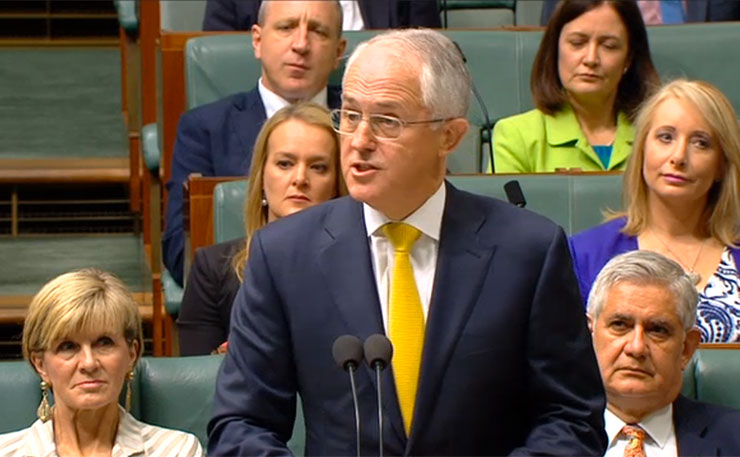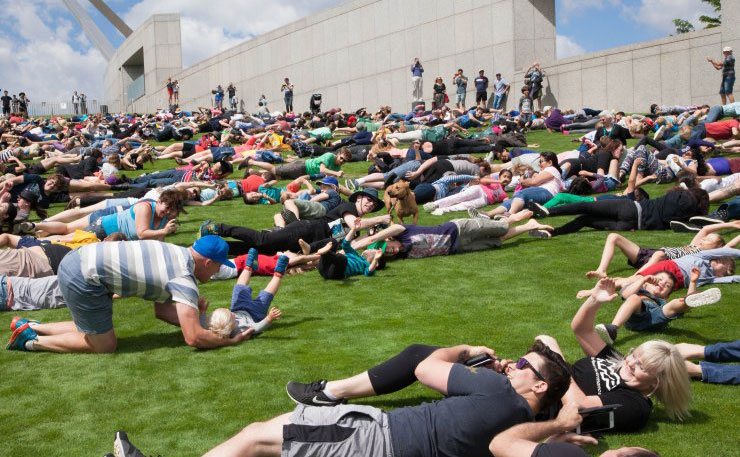In the absence of a genuine security threat to scare the punters, just make one up. Ian McAuley takes aim at the latest Turnbull Government scare campaign.
On November 30, the second-last sitting day of Federal Parliament, a group of protestors shouting “bring them home” and “close the camps” interrupted question time in the House of Representatives.
I’m old-fashioned enough to believe that such a form of protest is inappropriate. But I’m also old-fashioned enough to believe that this wasn’t the only assault on democracy going on in Parliament, for their protest broke out just as Melissa Price, Liberal member for Durack, WA, was on her feet with a “Dorothy Dix” question, asking the Prime Minister if he could update the house on the government’s achievements.
The script for such a question and response is straight out of North Korea’s propaganda handbook. An apparatchik asks the Dear Leader to recount his dedication to the people, the wonderful progress of the People’s Republic, the bountiful grain harvest, and so on. Only the occasional word needs to be changed for the Dear Leader’s script to fit Turnbull’s response.
Another old-fashioned belief is that Question Time is when ministers are held to account by backbenchers, particularly opposition backbenchers. But in reality it’s all carefully scripted. In every department public servants, co-opted into the political process, are required to anticipate opposition questions, and to draft responses with the appropriate mix of spin, casuistry, sophistry and bullshit – anything that avoids exposing the government’s weaknesses. Ministers go into Parliament armed with folders of partisan responses to “possible parliamentary questions“, all prepared by people on the public payroll.

And, of course, when both government and the opposition are on the same indefensible ground, as is the case with asylum seekers, hard questions never get asked. That callous indifference is what prompted the protest.
Unsurprisingly the government’s response to this mild protest was extreme, and it was framed as a “security” issue. So the next day, Parliament’s final sitting day, the government rushed through a bill to increase security measures at Parliament House, including a 2.6 metre steel security fence around the perimeter, blocking access to the lawns sweeping over the building.
Governments don’t draft bills overnight, and it’s clear that this had been sitting in a drawer for many months, waiting for an opportunity, an opportunity that came on that same morning when protesters unfurled a protest banner on the front of the building, again about the detention of asylum-seekers in concentration camps.
In a gesture of contempt for Parliament, parliamentarians were allowed access to the security briefing, which supposedly justifies the bill, only under supervision, without being allowed to keep or copy it.
While Labor, the Coalition, One Nation and the Xenophon Senators supported the bill, to their credit The Greens and Derryn Hinch stood out as lone voices in opposition.

In the community, however, there was plenty of opposition, including from some of Australia’s most respected architects.
The architect Romaldo Giurgola, whose firm won the original design contest for Parliament House, had a vision of Parliament as a place belonging to the people, and part of the realization of that vision was to have a continuous sweep of lawns, allowing people to walk right over the building. That was to maintain the original contours of Capital Hill, and to ensure it retained some vestige of vegetation.
But the strongest aspect of his vision was that people – citizens who actually owned the building and who provided it for their representatives’ use – could walk right over the top of where their representatives were working.
It’s the same symbolism embodied in Norman Foster’s design of the glass cupola over Germany’s Reichstag, which incorporates a walkway allowing people to look down, from a lofty height, on their elected representatives far below.
The messages in these designs couldn’t be plainer: parliament is subordinate to the sovereign people, and in turn executive government is subordinate to parliament.
The fence carries the opposite message. Parliament will do what the executive demands, and as for the people, they should consider themselves fortunate to have any access at all to Parliament. It’s an extension of the message that government, rather than constituted as belonging for the people and working for the public purpose, is some separate agency – an authoritarian agency perched on a defended hill.
And no doubt while the democratic symbolism is trashed, it will still be just as easy for lobbyists representing so-called “business interests” to gain access to Parliament: if you have the right connections a security pass is easy to come by. You don’t have to shout from the visitors’ gallery and get dragged out by police; you’ll be welcomed to your favoured minister’s office.
This isn’t the first assault on Giurgola’s democratic vision. Some years ago, under a similar security pretense, the Howard Government erected a small security fence near the top of the lawns, preventing complete “over-the-top” access.
This time Lester Yao, an otherwise quiet Canberra citizen, organized an event involving, he estimated, about 200 people rolling down the hill in what he called a “day of fun and freedom”.

As it was, I estimate that this time about 800 people turned up. And for them it was about much more than “fun” – there are plenty of hills in Canberra for people to roll down. One lady told me she brought her grandchildren so they could have at least some memory of what sort of country Australia once was.
And as for security, it’s a farce. Any terrorist with basic military training, using standard infantry weapons, could still launch an attack on Parliament House – an attack with all the requisite spectacle, but perhaps not many casualties. Parliament House would have to be encased in armour-plate steel to provide complete security. But why pick on Parliament House? A fanatic idiot with a suicide belt could attack any number of “soft” targets, causing multiple casualties, with much more impact, as has been happening in France and Belgium.
If this government were taking security seriously it would be investing less in “security theatre” such as fences around Parliament House and more in grunt-work intelligence. It wouldn’t be allowing commercial interests to displace security concerns, as it has done at our airports, issuing thousands of “airside” security passes to airport shopping centre staff.
It wouldn’t allow its immigration minister to stir up ethnic tension with intemperate claims about Lebanese immigrants.
And it would stop making refugees feel unwelcome.
Donate To New Matilda
New Matilda is a small, independent media outlet. We survive through reader contributions, and never losing a lawsuit. If you got something from this article, giving something back helps us to continue speaking truth to power. Every little bit counts.





